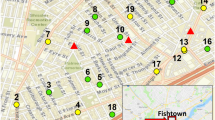Abstract
The inorganic and organic chemical composition of weathering sulphate patinas on the limestone walls of Emmanuel College, Cambridge, UK, have been analysed by FT-IR spectroscopy, pyrolysis gas-chromatography/mass spectrometry and scanning electron microscopy. The College location is characterized by heavy vehicular exhaust emissions including those from diesel powered public transport vehicles due to its proximity to the main Cambridge coach station. A complex mixture of gaseous and particulate air pollutants are found deposited in the weathering patinas including organic compounds (such as PAHs), which represent markers for present-day vehicular pollution. Slight differences in composition between patinas collected at different heights on the building facades with, in particular, more evidence for a biogenic overprint in samples collected at roof level as opposed to ground (street) level are found. Analytical results confirm how building stones in urban areas acted in the past and still do today as passive repositories for any kind of gaseous and particulate air pollutant present in the surrounding atmosphere; accordingly, weathering patinas are slowly changing their composition to accommodate new classes of present-day air pollutants.








Similar content being viewed by others
References
Antill SJ, Viles HA (1999) Deciphering the impacts of traffic on stone decay in Oxford: some preliminary observations from old limestone walls. In: Jones, MS, Wakefield RD (eds) Aspects of stone weathering, decay and conservation. Imperial College Press, London, pp 28–42
Ausset P, Crovisier JL, DelMonte M, Furlan V, Girardet F, Hammecker C, Jeannette D, Lefevre RA (1996) Experimental study of limestone and sandstone sulphation in polluted realistic conditions: the Lausanne Atmospheric Simulation Chamber (LASC). Atmos Environ 30(18):3197–3207
Cheng RJ, Hwu JR, Kim JT, Leu SH (1987) Deterioration of marble structures: the role of acid rain. Anal Chem 59:2–10
Fobe B, Veugels G, Roekens E, van Grieken R, Hermosin B, Ortega-Calvo JJ, Sanchez del Junco A, Saiz-Jimenez C (1995) Organic and inorganic components in limestone weathering crusts from cathedrals in Southern and Western Europe. Environ Sci Technol 29:1691–1701
Johnson JB, Montgomery M, Thompson GE, Wood GC, Sage PW, Cooke MJ (1996) The influence of combustion-derived pollutants on limestone deterioration:2 the wet deposition of species. Corros Sci 38(2):267–278
Machill S, Althaus K, Krumbein WE, Steiger WE (1997) Identification of organic compounds extracted from black weathered surfaces of saxonean sandstones, correlation with atmospheric input and rock inhabiting microflora. Org Geochem 27:79–97
Mansfield T, Hamilton R, Ellis B, Newby P (1991) Diesel particulate emissions and the implications for the soiling of buildings. The Environmentalist 11(4):243–254
Nord AG, Ericsson T (1993) Chemical analysis of thin black layers on building stone. Studies Conserv 38:25–35
Purcell D (1967) Cambridge stone. Faber and Faber, London
Rodriguez-Navarro C, Sebastian-Pardo E (1996) Role of particulate matter from vehicle exhausts on porous building stones (limestone) sulphation. Sci Total Environ 187:79–91
Rogge WF, Mazurek MA, Hildemann LM, Cass GR, Simoneit BRT (1993) Quantification of urban organic aerosols at a molecular level: identification, abundance and seasonal variation. Atmos Environ 27A:1309–1330
Saiz-Jimenez C (1993) Deposition of airborne organic pollutants on historic buildings. Atmos Environ 27B:77–85
Saiz-Jimenez C (1995) Deposition of anthropogenic compounds on monuments and their effect on airborne microorganisms. Aerobiologia 11:161–175
Saiz-Jimenez C (1997) Biodeterioration vs biodegradation: the role of microorganisms in the removal of pollutants deposited on historic buildings. Int Biodet Biodegr 40(2–4):225–232
Saiz-Jimenez C, Grimalt J, Garcia-Rowe J, Ortega-Calvo JJ (1991) Analytical pyrolysis of lichen thalli. Symbiosis 11:313–326
Schiavon N (1991) Gypsum crust formation and ‘stratigraphy’ in weathered building limestones: a SEM study of stone decay in the UK. In: Baer NS, Sabbioni C, Sors AI (eds) Science, technology and European cultural heritage. Butterworth and Heinemann, London, pp 447–450
Schiavon N, Zhou LP (1996) Magnetic, chemical and microscopical characterization of urban soiling on historical monuments. Environ Sci Technol 30(12):3624–3629
Schiavon N, Chiavari G, Fabbri D, Schiavon G (1994) Microscopical and chemical analysis of black patinas on granite. In: Fassina V, Ott H, Zezza F (eds) Stone and monuments: methodologies for the analyses of weathering and conservation, Venice, pp 93–99
Schiavon N, Chiavari G, Schiavon G, Fabbri D (1995) Nature and decay effects of urban soiling on granitic building stones. Sci Total Environ 167:87–101
Searle DE, Mitchell DJ, Halsey DP, Dews SJ, Smith JP (2000) The effects of coal and diesel particulates on the weathering loss of two major building stones in the UK — a comparative microcatchment study. In: Fassina V (ed) 9th International Congress on Deterioration and Conservation of Stone, Venice, pp 391–400
Simoneit BRT (1986) Characterisation of organic constituents in aerosols in relation to their origin and transport: a review. Int J Environ Anal Chem 23:207–237
Standley LJ, Simoneit BRT (1987) Characterisation of extractable plant wax, resin, and thermally matured components in smoke particles from prescribed burns. Environ Sci Technol 21:163–169
Viles HA (1996) Monitoring the effects of the Oxford transport strategy on building stone decay and soiling. In: Riederer J (ed) 8th International Congress on Deterioration and Conservation of Stone. Möller Druck und Verlag, Berlin, pp 831–834
Yu ML, Hites RA (1981) Identification of organic compounds on diesel engine soot. Anal Chem 53:951–954
Acknowledgement
Nick Schiavon would like to thank the Master and Fellows of Emmanuel College, Cambridge, for permission to work on the North Court building and the Department of Earth Sciences of Cambridge University where the first part of the research presented in this article was carried out.
Author information
Authors and Affiliations
Corresponding author
Rights and permissions
About this article
Cite this article
Schiavon, N., Chiavari, G. & Fabbri, D. Soiling of limestone in an urban environment characterized by heavy vehicular exhaust emissions. Env Geol 46, 448–455 (2004). https://doi.org/10.1007/s00254-004-1046-8
Published:
Issue Date:
DOI: https://doi.org/10.1007/s00254-004-1046-8




